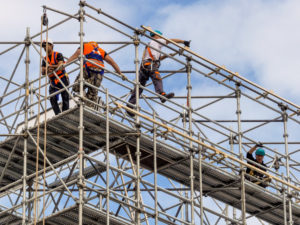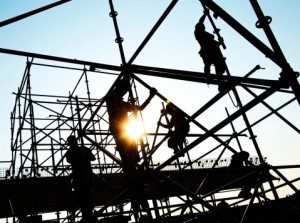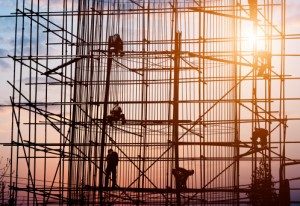Under federal law, you are entitled to a safe workplace. Your employer must provide a workplace free of known health and safety hazards. If you believe working conditions are unsafe or unhealthful, you may file a confidential complaint and ask for an inspection. If possible, bring the conditions to your employer’s attention. It is illegal for an employer to fire, demote, transfer or otherwise retaliate against a worker for using their rights under the law. Informed employers and workers, in compliance with correct safety standards, can save as many as 50 lives and prevent 4,500 accidents every year.
The New York and New Jersey construction injury lawyers at the Ginarte law firm can help you get the compensation you deserve after a scaffold accident. Our law firm works with a team of construction site experts, building engineers, and site investigators to discover the cause of the worker’s injury was and to determine whether other legal actions may exist. If you, or a loved one, were hurt in a fall from a scaffold, we will fight to get you the money you deserve.
SCAFFOLD SAFETY
An estimated 2.3 million construction workers, or 65 percent of the construction industry, work on scaffolds. In a recent Bureau of Labor Statistics (BLS) study, 72 percent of workers injured in scaffold accidents attributed the accident either to the planking or support giving way, or to the employee slipping or being struck by a falling object. All of these accidents can be controlled by compliance with the Occupational Safety and Health Administration standards.
“The Occupational Safety and Health Act of 1970 (OSH Act) was passed to prevent workers from being killed or seriously harmed at work. This law created the Occupational Safety and Health Administration (OSHA), which sets and enforces protective workplace safety and health standards. OSHA also provides information, training, and assistance to employers and workers. Under the OSH Act, employers have the responsibility to provide a safe workplace.” OSHA standards are rules that describe the methods employers are legally required to follow to protect their workers from hazards. OSHA standards include requirements to provide fall protection and provide training for certain dangerous jobs.

According to OSHA standard 1910.28(a)(1), Scaffolds shall be furnished and erected in accordance with this standard for persons engaged in work that cannot be done safely from the ground or from solid construction. 1910.28(a)(2) adds, The footing or anchorage for scaffolds shall be sound, rigid, and capable of carrying the maximum intended load without settling or displacement. Unstable objects such as barrels, boxes, loose brick, or concrete blocks shall not be used to support scaffolds or planks. OSHA has a complete guide to Scaffold Use in the Construction Industry as part of their Small Business Safety Management Series.
This Guide Outlines the Scaffold Standards as follows:
- Fall protection or fall arrest systems—Each employee more than 10 feet above a lower level shall be protected from falls by guardrails or a fall arrest system, except those on single-point and two-point adjustable suspension scaffolds. Each employee on a single-point and two-point adjustable suspended scaffold shall be protected by both a personal fall arrest system and a guardrail. 1926.451(g)(1)
- Guardrail height—The height of the toprail for scaffolds manufactured and placed in service after January 1, 2000 must be between 38 inches (0.9 meters) and 45 inches (1.2 meters). The height of the toprail for scaffolds manufactured and placed in service before January 1, 2000 can be between 36 inches (0.9 meters) and 45 inches (1.2 meters). 1926.451(g)(4)(ii)
- Crossbracing—When the crosspoint of crossbracing is used as a toprail, it must be between 38 inches (0.97 m) and 48 inches (1.3 meters) above the work platform. 1926.451(g)(4)(xv)
- Midrails— Midrails must be installed approximately halfway between the toprail and the platform surface. When a crosspoint of crossbracing is used as a midrail, it must be between 20 inches (0.5 meters) and 30 inches (0.8 m) above the work platform. 1926.451(g)(4)
- Footings—Support scaffold footings shall be level and capable of supporting the loaded scaffold. The legs, poles, frames, and uprights shall bear on base plates and mud sills. 1926.451(c)(2)
- Platforms—Supported scaffold platforms shall be fully planked or decked. 1926.451(b)
- Guying ties, and braces—Supported scaffolds with a height-to-base of more than 4:1 shall be restained from tipping by guying, tying, bracing, or the equivalent. 1926.451(c)(1)
- Capacity—Scaffolds and scaffold compponents must support at least 4 times the maximum intended load. Suspension scaffold rigging must at least 6 times the intended load. 1926.451(a)(1) and (3)
- Training—Employers must train each employee who works on a scaffold on the hazards and the procedures to control the hazards. 1926.454
- Inspections—Before each work shift and after any occurrence that could affect the structural integrity, a competent person must inspect the scaffold and scaffold components for visible defects. 1926.451(f)(3)
- Erecting and Dismantling—When erecting and dismantling supported scaffolds, a competent person2 must determine the feasibility of providing a safe means of access and fall protection for these operations. 1926.451(e)(9) & (g)(2)
SCAFFOLD TRAINING
Safety regulations are important to prevent scaffold-related accidents, but properly training employees to construct and use these scaffolds is equally important. Studies showed that 25% of workers injured in scaffold accidents had received no scaffold safety training. Proper training insures that these regulations are followed and carried out properly, providing additional safety for these workers.
All employees who work on a scaffold must be trained by a person qualified to recognize the hazards associated with the type of scaffold used and to understand the procedures to control and minimize those hazards. 1926.454(a)
A competent person must train all employees who erect, disassemble, move, operate, repair, maintain, or inspect scaffolds. Training must cover the nature of the hazards, the correct procedures for erecting, disassembling, moving, operating, repairing, inspecting, and maintaining the type of scaffold in use. 1926.454(b) Other recommended training topics include erection and dismantling, planning, personal protective equipment, access, guys and braces, and parts inspection. Appendix D
The standard requires retraining when (1) no employee training has taken place for the worksite changes, scaffold changes, or falling object protection changes; or (2) where the employer believes the employee lacks the necessary skill, understanding, or proficiency to work safely. 1926.454(c)
SCAFFOLD FALL PREVENTION
Falls are among the top causes of workplace injuries. Contracting companies and property owners are required to provide safety equipment to prevent workers’ falls from scaffolds. When safety devices aren’t in place, or don’t function properly, workers fall and suffer serious injury or death. All workers should feel secure that their work environment is a safe one, so those who neglect safety regulations should be held liable for the injured worker’s losses including: recovery for expenses, pain, and suffering.
Amerisafe cites the phrase “Long Way – up, Long Way Down” as the phrase used for the most common accident involving scaffolding; Falls. Studies show that half of all people hitting a hard surface with a velocity of 18 miles per hour- that’s 27-feet per second- will be killed. This means you could die from a fall of only 11-feet. 90% of all falls involving scaffolds happen while workers are performing routine jobs and that the average height of those falls are 12 to 15 feet.
Amerisafe provides these additional safety tips to prevent falls:
- Follow the manufacturer’s instructions when erecting the scaffold.
- Do not work on scaffolds outside during stormy or windy weather.
- Do not climb on scaffolds that wobble or lean to one side.
- Initially inspect the scaffold prior to mounting it. Do not use a scaffold if any pulley, block, hook or fitting is visibly worn, cracked, rusted or otherwise damaged.
- Do not use a scaffold if any rope is frayed, torn or visibly damaged.
- Do not use any scaffold tagged “Out of Service”.
- Do not use unstable objects such as barrels, boxes, loose brick or concrete blocks to support scaffolds or planks.
- Do not work on platforms or scaffolds unless they are fully planked.
- Do not use a scaffold unless guardrails and all flooring are in place.
- Level the scaffold after each move. Do not extend adjusting leg screws more than 12 inches.
- Do not walk or work beneath a scaffold unless a wire mesh has been installed between the mid-rail and the toe-board or planking.
- Use your safety belts and lanyards when working on scaffolding at a height of 10 feet or more above ground level. Attach the lanyard to a secure member of the scaffold.
- Do not climb the cross braces for access to the scaffold. Use the ladder.
- Do not jump from, to, or between scaffolding.
- Do not slide down cables, ropes or guys used for bracing.
- Keep both feet on the decking. Do not sit or climb on the guardrails.
- Do not lean out from the scaffold. Do not rock the scaffold.
- Keep the scaffold free of scraps, loose tools, tangled lines and other obstructions.
- Do not throw anything “overboard” unless a spotter is available. Use the debris chutes or lower things by hoist or by hand.
- Do not move a mobile scaffold if anyone is on the scaffold.
- Chock the wheels of the rolling scaffold, using the wheel blocks, and also lock the wheels by using your foot to depress the wheel-lock, before using the scaffold.



Leave a Reply